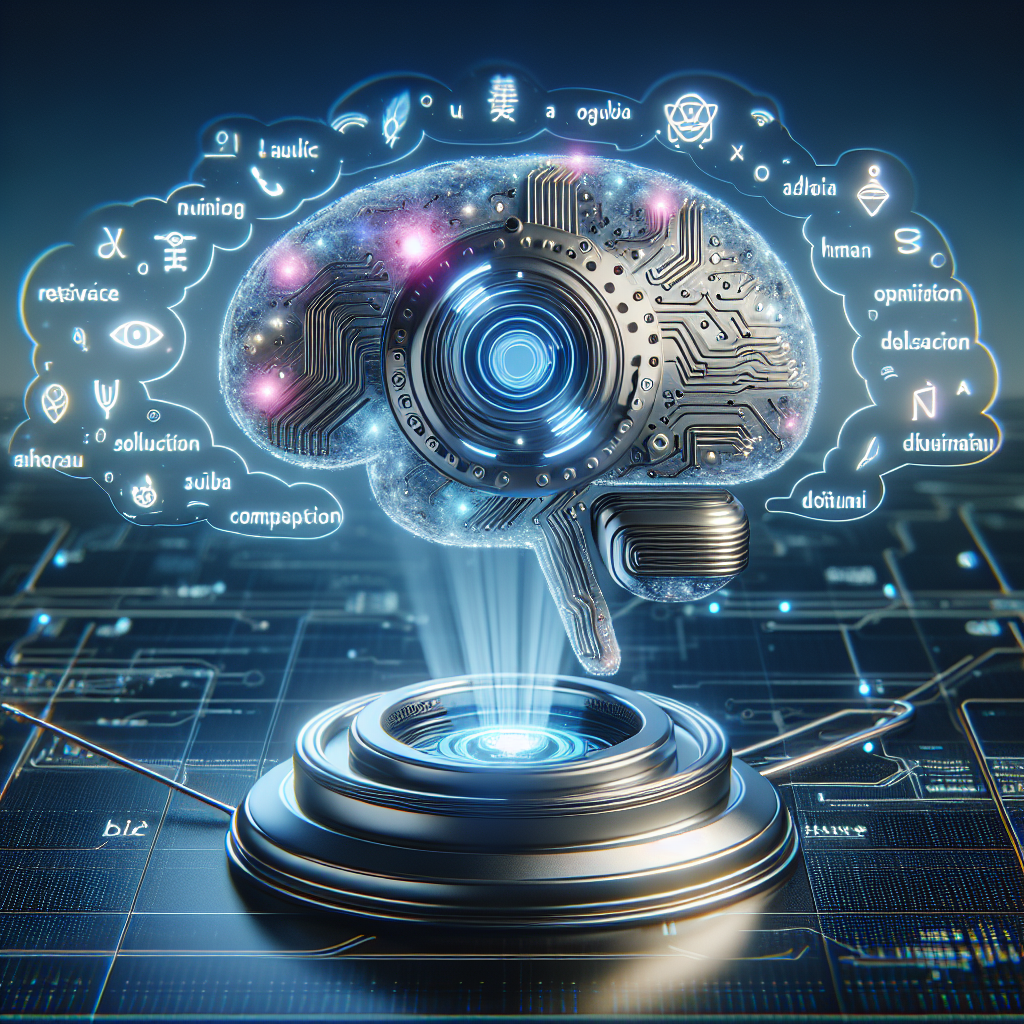-
Table of Contents
“Revolutionizing Communication: AI’s Leap in Natural Language Processing”
Introduction

Artificial Intelligence (AI) is revolutionizing the field of Natural Language Processing (NLP) by enabling machines to understand, interpret, and generate human language with unprecedented accuracy and efficiency. Through advanced algorithms, machine learning techniques, and vast datasets, AI-driven NLP systems are now capable of performing complex tasks such as language translation, sentiment analysis, and conversational interactions. These advancements are not only enhancing user experiences across various applications but also driving innovation in industries ranging from customer service to healthcare. By continuously learning from vast amounts of linguistic data, AI is pushing the boundaries of what is possible in human-computer communication, making interactions more intuitive and seamless.
Improving Language Translation Accuracy with AI
Artificial Intelligence (AI) has been making significant strides in various fields, and one of the most transformative areas is Natural Language Processing (NLP). This technology, which enables machines to understand, interpret, and generate human language, has seen remarkable advancements, particularly in the realm of language translation. The accuracy of language translation has always been a challenging task, but AI is now enhancing this process in ways that were previously unimaginable.
To begin with, traditional translation methods relied heavily on rule-based systems and extensive dictionaries. These systems, while useful, often struggled with the nuances and complexities of human language. Idiomatic expressions, cultural references, and context-specific meanings frequently led to errors and misunderstandings. However, the advent of AI, particularly through machine learning and deep learning techniques, has revolutionized this landscape. By training on vast amounts of multilingual data, AI models can now recognize patterns and make more accurate translations.
One of the key breakthroughs in this area has been the development of neural machine translation (NMT). Unlike its predecessors, NMT uses artificial neural networks to predict the likelihood of a sequence of words. This approach allows for more fluid and natural translations, as the system can consider entire sentences rather than just individual words or phrases. Consequently, the translations produced by NMT are often more coherent and contextually appropriate.
Moreover, AI’s ability to learn and adapt is another significant advantage. As these systems are exposed to more data, they continuously improve their performance. This iterative learning process means that AI-driven translation tools are constantly evolving, becoming more accurate and reliable over time. For instance, Google’s AI-powered translation service, Google Translate, has seen substantial improvements in recent years, thanks to its use of NMT and ongoing data input from users worldwide.
In addition to improving the accuracy of translations, AI is also enhancing the speed and efficiency of the process. Traditional translation methods could be time-consuming, especially for lengthy documents or complex texts. AI, on the other hand, can process and translate large volumes of text in a fraction of the time. This capability is particularly beneficial for businesses and organizations that operate on a global scale, as it allows them to communicate more effectively and efficiently with their international counterparts.
Furthermore, AI is not just limited to text-based translations. It is also making significant inroads in the realm of speech translation. Voice recognition technology, combined with AI-driven translation, enables real-time translation of spoken language. This development has profound implications for global communication, as it breaks down language barriers and facilitates more seamless interactions between people from different linguistic backgrounds.
Despite these advancements, it is important to acknowledge that AI-driven translation is not without its challenges. There are still instances where translations may fall short, particularly with highly specialized or technical language. Additionally, the ethical considerations surrounding AI, such as data privacy and algorithmic bias, must be carefully managed to ensure that these technologies are used responsibly.
In conclusion, AI is undeniably enhancing the accuracy and efficiency of language translation. Through the use of advanced techniques like neural machine translation and continuous learning, AI is transforming the way we communicate across languages. While challenges remain, the potential for AI to further improve and refine language translation is immense, promising a future where language barriers are increasingly diminished.
Enhancing Sentiment Analysis through Advanced AI Algorithms
Artificial intelligence (AI) has been making significant strides in various fields, and one of the most notable areas of advancement is natural language processing (NLP). Among the many applications of NLP, sentiment analysis stands out as a particularly impactful one. Sentiment analysis, the process of determining the emotional tone behind a series of words, is being revolutionized by advanced AI algorithms, leading to more accurate and nuanced interpretations of human language.
To begin with, traditional sentiment analysis relied heavily on basic algorithms and pre-defined dictionaries of positive and negative words. While these methods provided a rudimentary understanding of sentiment, they often fell short in capturing the complexities and subtleties of human emotions. Enter AI, with its ability to learn and adapt, offering a more sophisticated approach. Machine learning models, particularly those based on deep learning, have transformed sentiment analysis by enabling systems to understand context, irony, and even sarcasm, which were previously challenging to detect.
Moreover, the advent of transformer models, such as BERT (Bidirectional Encoder Representations from Transformers) and GPT (Generative Pre-trained Transformer), has further enhanced the capabilities of sentiment analysis. These models are pre-trained on vast amounts of text data and can be fine-tuned for specific tasks, including sentiment analysis. Their ability to consider the context of a word within a sentence, rather than in isolation, allows for a more accurate interpretation of sentiment. For instance, the phrase “I am not happy with the service” is clearly negative, but traditional models might struggle with the negation. Transformer models, however, can grasp the context and deliver a more precise sentiment score.
In addition to improved accuracy, AI-driven sentiment analysis offers scalability and efficiency. Businesses can now analyze vast amounts of data from social media, customer reviews, and other text sources in real-time. This capability is invaluable for companies looking to gauge public opinion, monitor brand reputation, or respond promptly to customer feedback. The speed and scale at which AI can process data far surpass human capabilities, making it an indispensable tool in today’s data-driven world.
Furthermore, AI algorithms are continually evolving, thanks to ongoing research and development. Techniques such as transfer learning and reinforcement learning are pushing the boundaries of what is possible in sentiment analysis. Transfer learning allows models to leverage knowledge gained from one task to improve performance on another, while reinforcement learning enables systems to learn from interactions and improve over time. These advancements ensure that sentiment analysis tools remain at the cutting edge, providing ever more accurate and insightful results.
However, it is essential to acknowledge the challenges that come with these advancements. One significant concern is the potential for bias in AI models. If the training data contains biased language or reflects societal prejudices, the AI system may inadvertently perpetuate these biases in its analysis. Addressing this issue requires careful curation of training data and ongoing efforts to ensure fairness and inclusivity in AI development.
In conclusion, AI is profoundly enhancing sentiment analysis through advanced algorithms that offer greater accuracy, efficiency, and scalability. The integration of deep learning and transformer models has revolutionized the field, enabling systems to understand the nuances of human language better than ever before. As research continues to push the boundaries, the potential applications of AI-driven sentiment analysis are vast, promising a future where businesses and individuals can gain deeper insights into the emotions and opinions that shape our world.
Revolutionizing Chatbots and Virtual Assistants with AI-Driven NLP
Artificial intelligence (AI) has made significant strides in recent years, particularly in the realm of natural language processing (NLP). This progress is revolutionizing the way chatbots and virtual assistants operate, making them more efficient, intuitive, and capable of understanding human language with unprecedented accuracy. As AI-driven NLP continues to evolve, it is transforming the landscape of digital communication and customer service.
One of the most notable advancements in AI-driven NLP is the ability to comprehend and generate human-like text. This capability is largely attributed to sophisticated models such as OpenAI’s GPT-3, which can understand context, infer meaning, and produce coherent responses. These models are trained on vast datasets, enabling them to recognize patterns and nuances in language that were previously challenging for machines to grasp. Consequently, chatbots and virtual assistants powered by these models can engage in more natural and meaningful conversations with users.
Moreover, the integration of AI-driven NLP into chatbots and virtual assistants has significantly improved their ability to handle complex queries. In the past, these systems often struggled with multi-turn conversations or questions that required a deeper understanding of context. However, with the advent of advanced NLP techniques, chatbots can now maintain context over multiple interactions, providing more accurate and relevant responses. This enhancement not only improves user satisfaction but also reduces the need for human intervention, streamlining customer service operations.
In addition to handling complex queries, AI-driven NLP has also enhanced the personalization of interactions. By analyzing user data and preferences, chatbots and virtual assistants can tailor their responses to meet individual needs. This level of personalization creates a more engaging and satisfying user experience, as individuals feel understood and valued. For businesses, this translates to higher customer retention rates and increased loyalty.
Furthermore, the ability to process and understand multiple languages is another significant benefit of AI-driven NLP. As global communication becomes increasingly important, chatbots and virtual assistants that can operate in various languages are invaluable. AI models can be trained on multilingual datasets, enabling them to provide accurate translations and understand diverse linguistic nuances. This capability not only broadens the reach of these systems but also ensures that non-native speakers receive the same level of service and support.
Despite these advancements, there are still challenges to overcome in the realm of AI-driven NLP. One such challenge is ensuring the ethical use of AI, particularly in terms of data privacy and bias. As these systems rely on large datasets, it is crucial to address concerns related to the collection and use of personal information. Additionally, efforts must be made to mitigate biases that may be present in the training data, as these can lead to unfair or discriminatory outcomes.
Nevertheless, the potential of AI-driven NLP to revolutionize chatbots and virtual assistants is undeniable. As technology continues to advance, we can expect even more sophisticated and capable systems that further enhance our digital interactions. By addressing current challenges and leveraging the power of AI, we are on the cusp of a new era in which chatbots and virtual assistants are not only tools but also trusted companions in our daily lives.
In conclusion, AI-driven NLP is transforming the capabilities of chatbots and virtual assistants, making them more adept at understanding and responding to human language. Through improved comprehension, personalization, and multilingual support, these systems are enhancing user experiences and streamlining customer service. While challenges remain, the future of AI-driven NLP holds immense promise, paving the way for more intuitive and effective digital communication.
Conclusion
AI is significantly enhancing Natural Language Processing (NLP) by improving the accuracy and efficiency of language understanding and generation. Advanced machine learning algorithms, particularly deep learning models like transformers, have enabled more sophisticated analysis of text, leading to better performance in tasks such as translation, sentiment analysis, and summarization. AI-driven NLP systems can now handle more complex language nuances, context, and even generate human-like text, making interactions with technology more intuitive and effective. This progress is opening up new possibilities in various fields, from customer service to content creation, ultimately transforming how we interact with and utilize language-based data.




